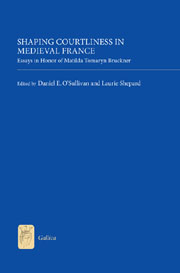Book contents
- Frontmatter
- Contents
- List of Illustrations
- Acknowledgements
- Introduction
- Matilda Tomaryn Bruckner: A Bibliography
- Part I Shaping Real and Fictive Courts
- A Perfume of Reality? Desublimating the Courtly
- Shaping the Case: the Olim and the Parlement de Paris under King Louis IX
- Charles d'Orléans and the Wars of the Roses: Yorkist and Tudor Implications of British Library MS Royal 16 F ii
- Part II Shaping Courtly Narrative
- Part III Shaping Women's Voices in Medieval France
- Part IV Shaping the Courtly Other
- Envoi
- List of Contributors
- Index
- Tabula Gratulatoria
- Already Published
A Perfume of Reality? Desublimating the Courtly
from Part I - Shaping Real and Fictive Courts
Published online by Cambridge University Press: 05 May 2013
- Frontmatter
- Contents
- List of Illustrations
- Acknowledgements
- Introduction
- Matilda Tomaryn Bruckner: A Bibliography
- Part I Shaping Real and Fictive Courts
- A Perfume of Reality? Desublimating the Courtly
- Shaping the Case: the Olim and the Parlement de Paris under King Louis IX
- Charles d'Orléans and the Wars of the Roses: Yorkist and Tudor Implications of British Library MS Royal 16 F ii
- Part II Shaping Courtly Narrative
- Part III Shaping Women's Voices in Medieval France
- Part IV Shaping the Courtly Other
- Envoi
- List of Contributors
- Index
- Tabula Gratulatoria
- Already Published
Summary
For Tilda: Narrative invention, shaping romance with multiple interpretations, creates truths continuations, history and knowledge live or die by.
The primacy of materiality is universal
Louis AlthusserThe advent of “the courtly” marks a turning point in European literary history – a “beginning” in culture or civilization, rightly celebrated. Yet, as long recognized, something about it isn't quite kosher.
Expressions like “courtliness,” “courtly literature,” “courtly love,” or the shamed, self-annulling citational periphrasis “the literature once called ‘courtly,’” have currency in both medievalist and modernist discourses. They purportedly ground the sublimity of literary representations by referring to a historical institution that guarantees the historical existence of the substance designated – manners, literature, love – by connecting representations and a historical institution – standing in for “reality.” The verbal coupling [courtly + noun], its essentialization [courtliness], or even the reference by ellipsis, suggest a conceptual identity derived from lexical contiguity allowing semantic seepage from court to text – or vice versa.
Might the usage suggest examination of historical courts? Might such examination discover that the semantic content assumed for “court” disfigures it? Is “courtly” an unexamined ontological warrantee, a seeming historical reference turning into an alibi for the slide into cultural ruminations or a dehistoricized Lacanism built on metonymic strategies of evasion: not false, but as extravagantly anamorphic as the skull in Las Meninas?
- Type
- Chapter
- Information
- Shaping Courtliness in Medieval FranceEssays in Honor of Matilda Tomaryn Bruckner, pp. 25 - 46Publisher: Boydell & BrewerPrint publication year: 2013

